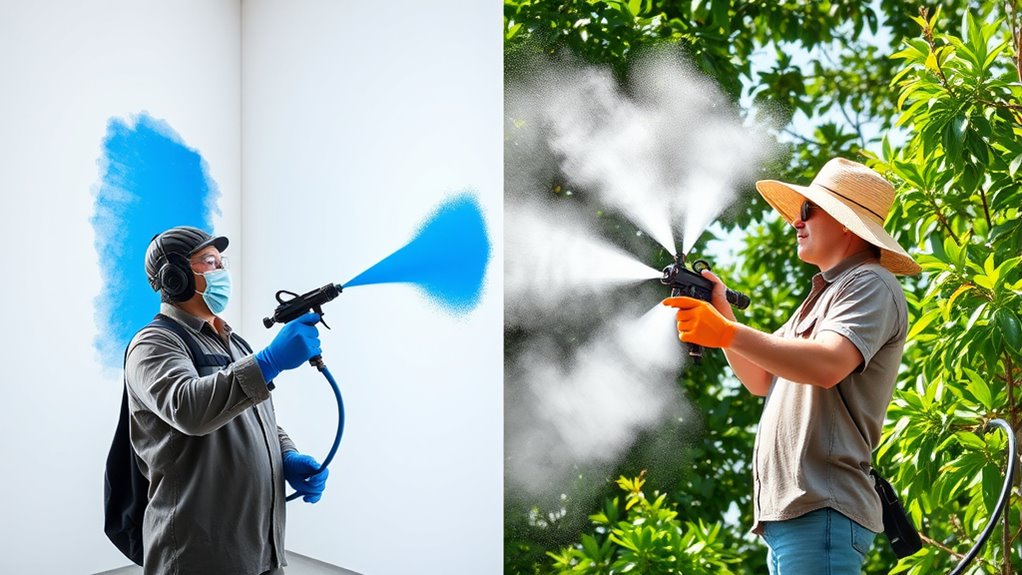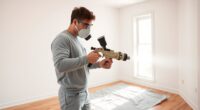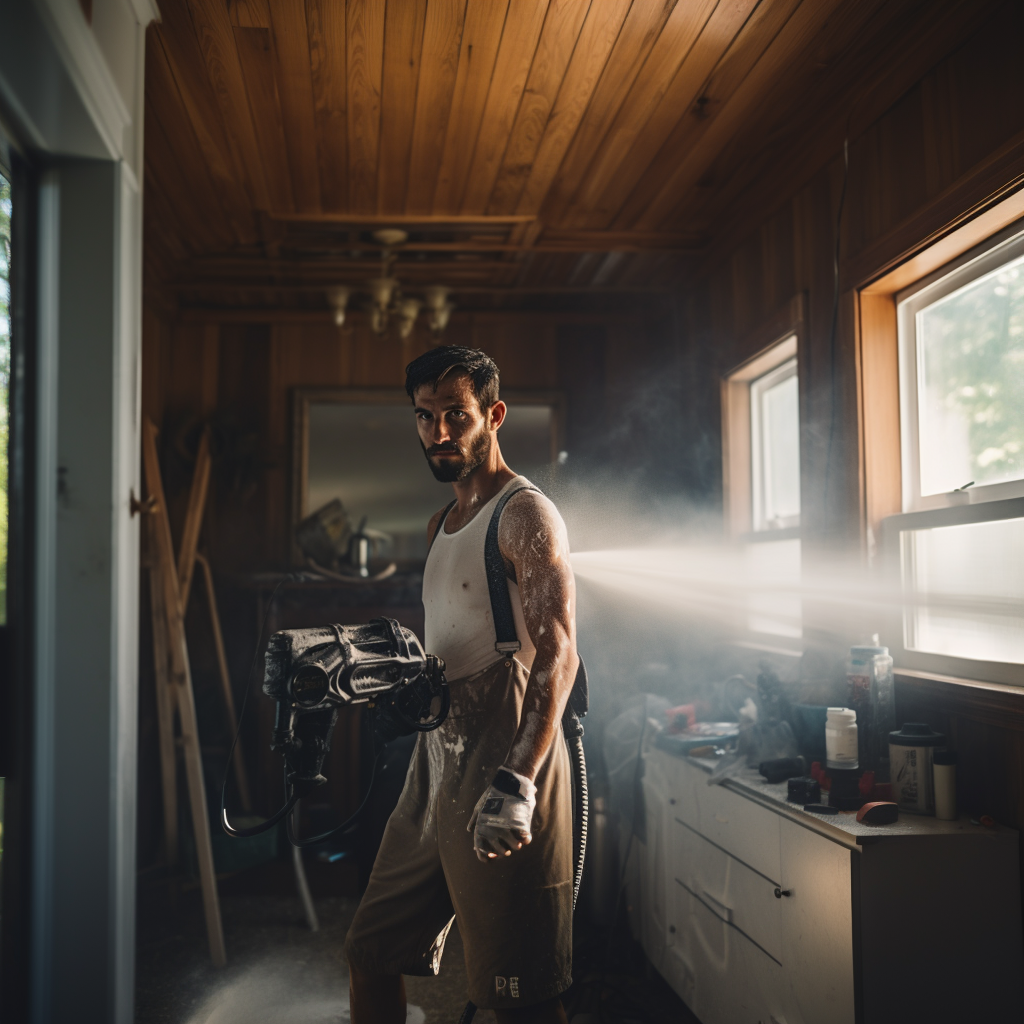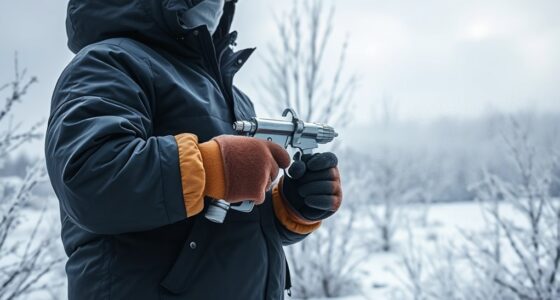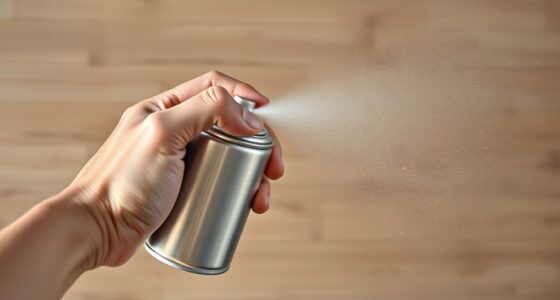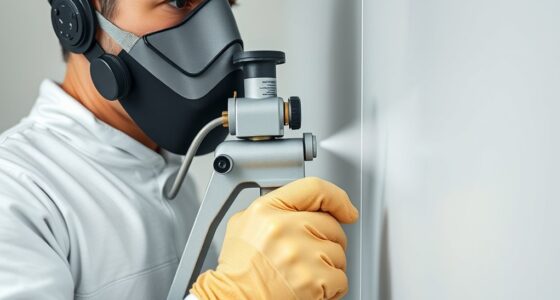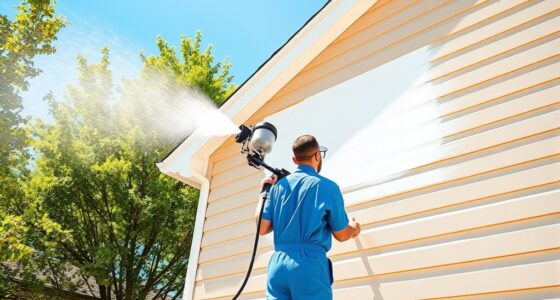When spraying indoors versus outdoors, you must adjust your techniques and equipment. Indoor projects require smaller, precise tools, good ventilation, and careful surface preparation to avoid fumes and overspray. Outdoors, you’ll face weather, wind, and larger areas, so choose weather-resistant equipment, monitor conditions, and use protective coverings. Proper surface prep and consistent application matter for both. If you continue exploring, you’ll discover detailed tips to help you achieve a flawless finish in any environment.
Key Takeaways
- Indoor spraying requires controlled environment, proper ventilation, and low VOC paints for safety and quality.
- Outdoor spraying demands weather monitoring, wind protection, and durable, UV-resistant paints for longevity.
- Technique differences include steady gun distance, pattern overlap, and multiple thin coats for both settings.
- Surface prep like cleaning, sanding, and priming is essential regardless of indoor or outdoor application.
- Safety measures such as protective gear and equipment stability are critical in both environments to ensure professional results.
Equipment and Setup for Indoor and Outdoor Spraying
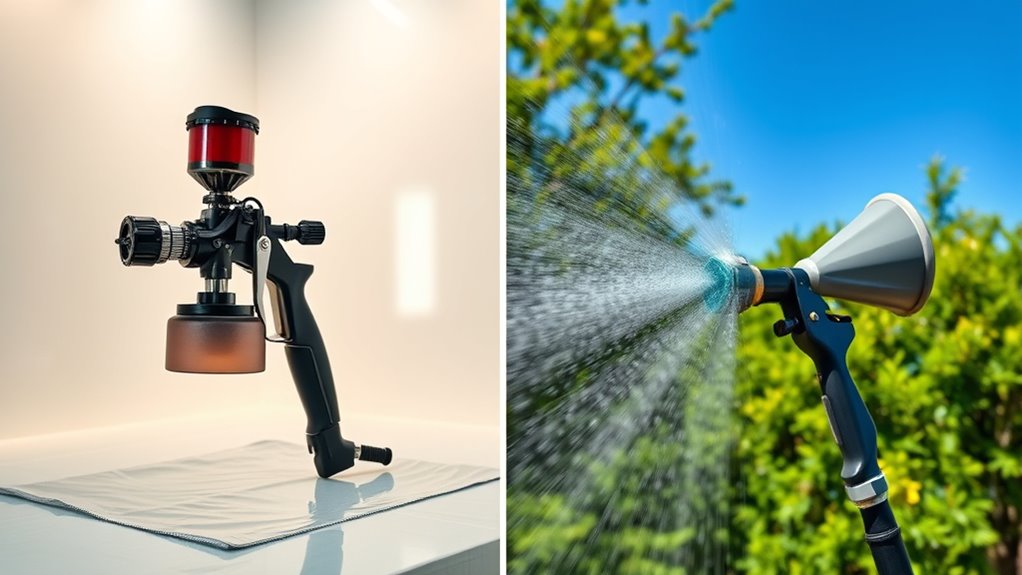
When setting up for indoor or outdoor paint spraying, choosing the right equipment is crucial to guarantee a smooth process. Start by inspecting your spray gun to confirm proper calibration; accurate spray gun calibration prevents uneven coverage and overspray. Regular brush maintenance is also essential, especially when switching between tasks, to keep parts clean and functioning smoothly. For outdoor spraying, consider equipment with higher capacity and weather-resistant features, while indoor setups benefit from smaller, more precise tools. Properly calibrated spray guns deliver consistent results, reducing waste and rework. Keep your equipment well-maintained to avoid downtime and guarantee excellent performance throughout the project. Additionally, using easy-to-clean equipment simplifies maintenance routines and extends the lifespan of your sprayer. Implementing durable tools designed to withstand environmental conditions can further enhance the quality of outdoor painting projects. To ensure optimal results, it is also beneficial to select appropriate spray tips tailored for specific surfaces and paint types. Regularly checking and adjusting pressure settings during application helps achieve a uniform spray pattern and finish.
Surface Preparation and Protection Techniques
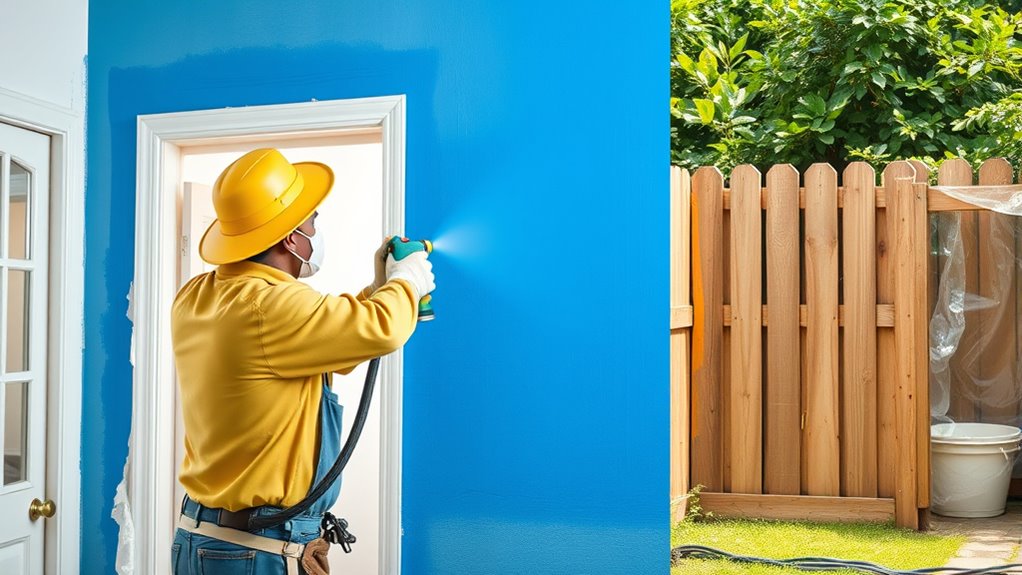
Proper surface preparation and protection set the foundation for a flawless paint job. Begin by cleaning the surface thoroughly to remove dust, grease, and debris. Sand rough areas to ensure smoothness, and apply a suitable surface primer to promote adhesion and durability. Priming also helps hide stains and creates a uniform base for the paint. Next, guard surrounding areas with protective coverings like drop cloths, plastic sheeting, or painter’s tape. Cover furniture, floors, and adjacent walls to prevent overspray and splatters. For outdoor projects, consider additional barriers like tarps or landscaping fabric to shield plants and ground surfaces. Taking these steps ensures your paint adheres properly, results look professional, and cleanup becomes easier. Proper surface prep and protection are essential for a high-quality finish. Additionally, understanding the design style can influence the choice of protective materials and preparation techniques to achieve a cohesive look. Using the correct watering systems, such as self-watering planters, can also help maintain consistent moisture during the painting process for indoor plants. Incorporating mental wellbeing considerations into your planning can help reduce stress and improve focus during your project. Moreover, applying data-driven strategies can help you evaluate your progress and ensure the quality of your work throughout the project. Being aware of essential oil benefits can also provide calming aromatherapy options to create a more relaxing workspace during your painting tasks.
Environmental Factors and Their Impact on Spray Painting
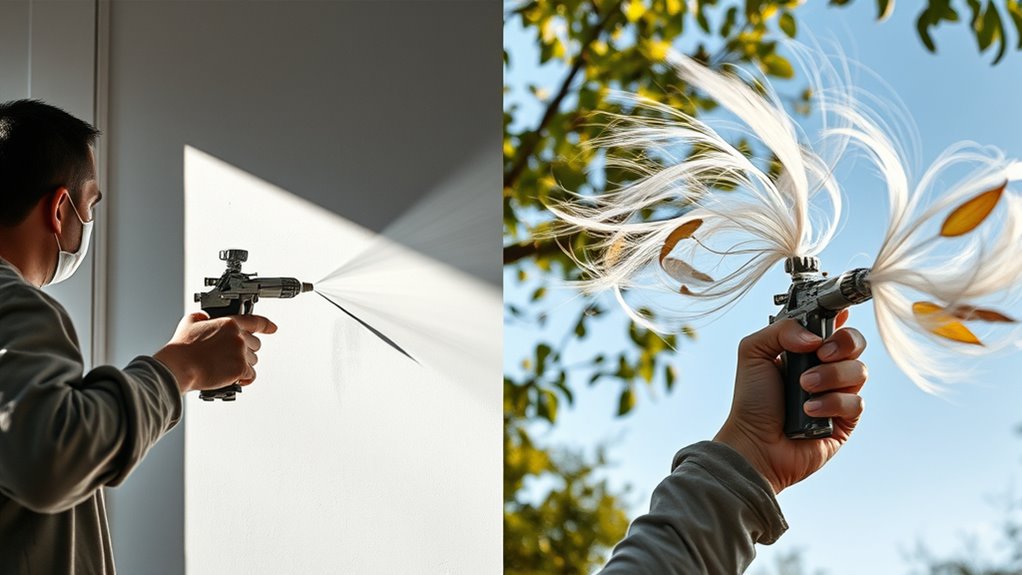
Environmental factors play a critical role in spray painting outcomes, as conditions like temperature, humidity, and wind can markedly affect the application process and final appearance. Wind effects can cause overspray and uneven coats, so controlling wind is essential outdoors. Temperature control influences drying times and paint adhesion; extreme heat or cold can compromise results. To minimize issues, monitor weather forecasts and choose ideal times for painting. Here’s a quick comparison:
| Factor | Effect | Tip |
|---|---|---|
| Wind effects | Causes overspray, uneven finish | Wait for calm conditions |
| Temperature control | Affects drying and adhesion | Paint in moderate temps |
| Humidity | Leads to bubbles and poor finish | Avoid high humidity days |
Safety Considerations for Both Environments
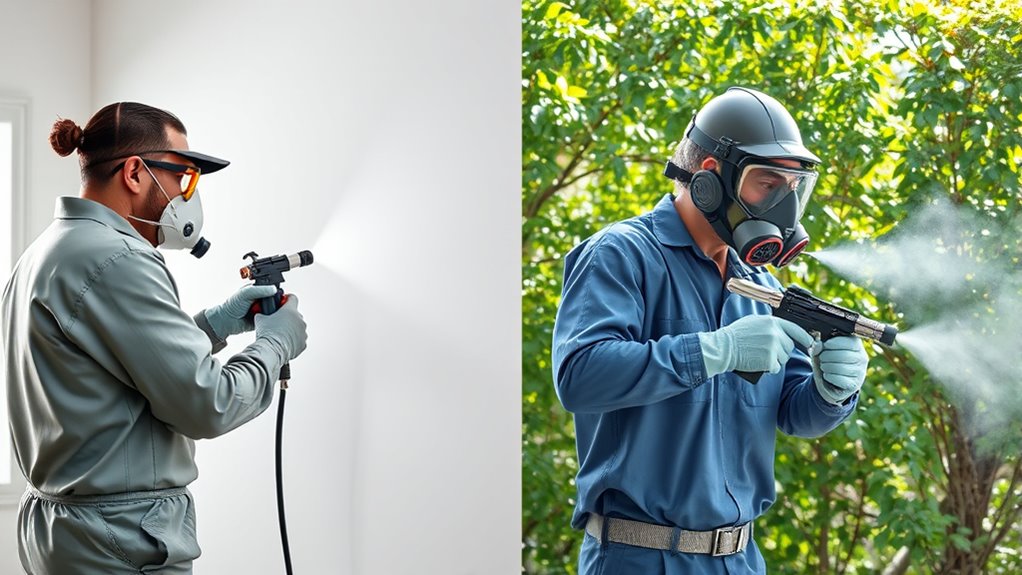
Safety should be a top priority whether you’re spray painting indoors or outdoors. Ventilation safety is vital to prevent the buildup of fumes, so make certain proper airflow by opening windows, using fans, or working in well-ventilated areas. Indoors, avoid enclosed spaces with poor ventilation, and outdoors, be aware of wind that could carry fumes toward others. Chemical exposure is another key concern; always wear protective gear such as masks, gloves, and goggles to shield your skin and respiratory system. Follow manufacturer instructions for proper handling and disposal of paints and solvents. Proper ventilation is especially critical in indoor environments to reduce health risks associated with fumes. Keep a cleaner workspace by eliminating sources of ignition and avoiding inhaling fumes directly. Prioritizing ventilation safety and minimizing chemical exposure helps protect your health and guarantees a safer spraying environment. Additionally, understanding the projector technology used in home cinemas can help you choose the safest and most effective setup for your space. Using proper storage practices for paints and solvents further reduces the risk of accidents and ensures a safer environment during and after your project. Regular maintenance of air purifiers can also help in reducing airborne contaminants indoors, contributing to a healthier workspace. Incorporating safety data sheets can provide critical information on chemical hazards and proper handling procedures.
Achieving a Professional Finish: Tips and Best Practices
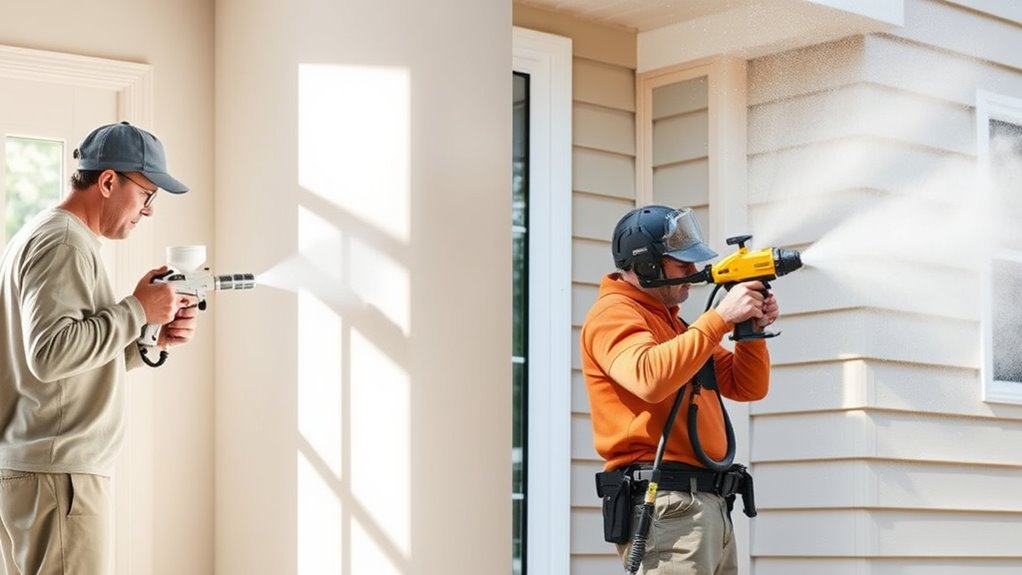
To achieve a professional finish when spray painting, preparation is key. Start with clean, smooth surfaces, and choose the right spray equipment. Maintain consistent paint consistency; thin your paint if it’s too thick, ensuring even application. Use proper brush techniques to smooth out edges and corners before spraying, which helps prevent drips and uneven coverage. Keep your spray gun at a steady distance from the surface—usually about 6-12 inches—to avoid drips and achieve a fine, even coat. Always overlap your passes slightly to prevent streaks. Practice on scrap material to perfect your technique. Taking your time and paying attention to detail will result in a polished, professional-looking finish that lasts. Knowing regional resources can also help you access expert advice and ensure you’re following best practices for your area. Additionally, understanding tanning tips can inform your approach to surface preparation and finishing to enhance durability and appearance. Incorporating water-based paints can also reduce fumes and improve environmental safety during your project. Being aware of Gold IRA regulations and best practices can serve as a useful analogy for understanding how choosing the right materials and preparation methods impact the final outcome. Moreover, considering the latest trends in AI-driven security systems can inspire innovative approaches to protecting your workspace and tools during your project.
Frequently Asked Questions
How Do Temperature Differences Affect Spray Paint Drying Times Indoors Versus Outdoors?
Temperature effects play a big role in how quickly spray paint dries. When it’s warmer indoors, paint dries faster because heat speeds up the evaporation process. Outdoors, cooler temperatures or wind can slow drying times or cause uneven finish. You should consider these factors to optimize paint drying, adjusting your spraying schedule accordingly. Maintaining a consistent temperature environment indoors generally guarantees more predictable paint drying compared to outdoor conditions.
What Are the Best Ventilation Methods for Indoor Spray Painting Projects?
In the days of yore, proper ventilation is key for indoor spray painting. You should use air filtration systems to trap fumes and particles, ensuring cleaner air. Exhaust fans are essential, pulling airborne overspray out of the workspace quickly. Position them strategically near the painting area, and keep windows open if possible. This combination minimizes inhalation risks, speeds up drying, and keeps your environment safe and fresh throughout your project.
How Does Humidity Impact Paint Adhesion in Outdoor Environments?
Humidity effects play a significant role in outdoor paint adhesion. When humidity levels are high, outdoor moisture can interfere with the paint’s ability to bond properly, causing issues like bubbling or peeling. You should check the weather forecast and avoid painting during or just after rain or heavy dew. Low humidity is ideal, as it allows the paint to dry and adhere more effectively, ensuring a durable finish.
Can Weather Conditions Change the Curing Process of Outdoor Paint Jobs?
Weather conditions can definitely change the curing process of outdoor paint jobs, affecting paint film formation and surface preparation. When temperatures drop or humidity rises, it slows down drying, making the paint less durable. Conversely, hot, windy days can cause quick drying and surface cracking. You need to monitor weather forecasts closely, ensuring ideal conditions for proper curing, which ultimately guarantees a smooth, long-lasting finish.
What Are Cost Differences Between Indoor and Outdoor Spray Painting Setups?
You’ll notice that outdoor spray painting setups typically cost more upfront due to equipment costs like weather-resistant gear and larger compressors. Material expenses also tend to be higher outdoors because you might need additional primers or sealers for weatherproofing. Indoor setups are usually cheaper, with smaller equipment and fewer protective materials needed. Overall, outdoor projects can be more expensive because of the extra equipment and materials required to handle the environment.
Conclusion
Whether you’re tackling a tiny indoor project or a massive outdoor masterpiece, your choices in equipment, prep, and safety can make or break your finish. Don’t underestimate the power of proper techniques—fail to prepare, and your work could look like a toddler’s finger painting! Master these considerations, and you’ll achieve a flawless, professional-looking result that’ll leave everyone in awe. Get it right, and your spray job will be legendary—like, museum-worthy legendary!
Franz came aboard the Paint Sprayer Zone team with a background in both journalism and home renovation. His articulate writing style, combined with a passion for DIY projects, makes him an invaluable asset. Franz has a knack for breaking down technical jargon into easy-to-understand content, ensuring that even the most novice of readers can grasp the complexities of paint sprayers.
